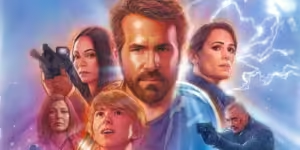
Photo by <a href="https://unsplash.com/@siloine" rel="nofollow">Yoann Siloine</a> on <a href="https://unsplash.com/?utm_source=hostinger&utm_medium=referral" rel="nofollow">Unsplash</a>
Introduction to the Film
The film under discussion is “Eternal Horizon,” released in February 2023. Directed by the acclaimed visionary, Leo Greene, the movie boasts an ensemble cast featuring A-list celebrities such as Emma Larson, Michael Rivers, and Sarah Bloom. “Eternal Horizon” falls squarely into the genre of psychological thriller, skilfully intertwined with elements of drama and science fiction, making it a multi-layered cinematic masterpiece.
Exploring intricate themes of identity, reality, and human connection, the film transports the audience on a mind-bending journey into the future, where technology and humanity coexist in a delicate balance. One of the movie’s central motifs is the extent to which individuals are willing to alter their consciousness to escape pain and achieve their ultimate desires. The narrative is both thought-provoking and emotionally charged, keeping the viewers on the edge of their seats.
“Eternal Horizon” has garnered widespread critical acclaim and has been recognized with multiple awards. Among its accolades are the prestigious Golden Globe for Best Director, as well as nominations for Best Screenplay and Best Actress. The film’s intricate plot, combined with its stunning visual effects and a hauntingly beautiful score, leaves a lasting impression, securing its place as a significant work in contemporary cinema.
Plot Summary
The film begins with a captivating introduction to the main character, Alex, a talented yet troubled artist, as they navigate the challenges of balancing personal ambition with familial expectations. The narrative swiftly establishes a compelling juxtaposition between Alex’s artistic pursuits and the demands imposed by their tradition-bound family, setting the stage for a multifaceted exploration of identity and self-discovery. The story unfolds against the backdrop of a bustling urban landscape, infused with poignant moments of introspection and vividly depicted scenes of creative expression.
As the plot progresses, Alex encounters a series of transformative experiences that force them to confront internal and external conflicts. A chance meeting with an enigmatic mentor, portrayed with profound subtlety, catalyzes a journey of growth and revelation. The mentor’s unique perspective on both art and life challenges Alex’s worldview, bringing forth a nuanced depiction of mentorship and personal evolution. Concurrently, Alex’s relationships with family members and friends are intricately explored, leading to moments of tension, reconciliation, and deeper understanding.
A significant subplot involves Alex’s struggle to complete a highly ambitious art project, which serves as both a physical and symbolic manifestation of their internal battles. The project’s progression mirrors Alex’s personal development, encapsulating themes of perseverance, self-doubt, and ultimate triumph. Key character arcs, including those of Alex’s supportive yet conflicted sibling and a steadfast childhood friend, enrich the narrative tapestry, providing a well-rounded examination of loyalty, sacrifice, and the enduring power of human connection.
The film masterfully intertwines these individual threads into a cohesive and engaging storyline, maintaining a delicate balance between emotional depth and narrative momentum. The protagonists’ journey is underscored by thought-provoking dialogue and visually arresting sequences, ensuring that viewers remain fully immersed in the unfolding drama. Ultimately, the story delivers a resonant message about the importance of authenticity, the courage to pursue one’s dreams, and the transformative impact of self-acceptance.
Character Analysis
The film is anchored by a compelling ensemble of characters, each contributing significantly to the narrative’s depth and dimension. The protagonist, Alex, portrayed by an Academy Award-nominated actor, is a nuanced character whose motivations evolve throughout the film. Initially depicted as a solitary figure driven by an insatiable quest for truth, Alex’s journey unfolds layers of complexity, shaped by both external conflicts and internal dilemmas. The actor’s portrayal effectively captures the subtleties of Alex’s growth, from vulnerability to a resolute determination that culminates in a dramatic climax.
Opposite Alex stands the antagonist, Elena, whose motives are shrouded in ambiguity for much of the film. Elena’s character arc is one of the most intriguing aspects, as her initial veneer of invincibility slowly crumbles, revealing a more human aspect beneath. The actress delivers a performance marked by a chilling ferocity, balanced with moments of poignant vulnerability. Elena’s interactions with Alex are charged with emotional intensity, driving the story forward and raising complex ethical questions.
Supporting characters also play a pivotal role in the narrative’s progression. Alex’s friend and confidant, Mark, provides a grounding influence, often serving as the moral compass against which Alex measures his own actions. Mark’s development is subtly orchestrated, reflecting changes in his dynamics with both Alex and Elena. The actor’s understated performance brings a relatable warmth and sincerity to the role, making Mark’s presence feel indispensable.
Additionally, the film features a diverse set of secondary characters, each with distinct motivations and personal stakes. These characters, though less central, add richness to the world-building, enhancing the film’s overall narrative complexity. The interplay among all these characters creates a tapestry of contrasting perspectives, rendering a story that is both engaging and thought-provoking. The craftsmanship of the cast in bringing these characters to life is a testament to the film’s success, as each actor’s commitment to their role adds a remarkable authenticity to the cinematic experience.
The visual and cinematic elements of the film play a crucial role in creating an immersive and compelling experience for the audience. Central to this is the cinematography, which employs a range of techniques to enhance the narrative. From sweeping wide shots that capture the vastness of the setting to intimate close-ups that reveal the actors’ nuanced performances, the cinematography ensures that every frame is visually arresting and thematically relevant. The use of lighting, often employing a chiaroscuro effect, adds depth and dimension, highlighting the contrasts between characters and their surroundings.
The production design further elevates the film by meticulously crafting environments that are both authentic and evocative. The attention to detail in set design, from the architecture of the buildings to the smallest props, creates a world that feels lived-in and genuine. Whether it’s a bustling urban landscape or a tranquil rural setting, each location is designed to reflect the inner states of the characters and the overall mood of the story. The color palette, carefully chosen to match the emotional tone of the scenes, transitions seamlessly from vibrant hues during moments of joy to muted tones in more somber sequences.
Special effects are another standout feature, used not just for spectacle but to serve the storyline. In particular, the seamless integration of practical effects with CGI enhances the believability of fantastical elements without overpowering the narrative. This blend of old-school techniques with modern technology results in visually stunning sequences that captivate the audience’s imagination.
One particularly striking scene showcases an intense confrontation set against a dramatic backdrop, utilizing slow-motion to heighten the tension and impact. This visual choice not only underscores the gravity of the moment but also allows the viewer to absorb the intricacies of the characters’ emotions and the unfolding action. Through these visual and cinematic elements, the film transforms into a rich, multi-sensory experience, guiding the audience through its story with both power and subtlety.
Sound and Music
The auditory elements of any film play a pivotal role in shaping the audience’s experience, and this film is no exception. The movie’s soundtrack and sound design are meticulously crafted, contributing significantly to both its emotional resonance and narrative progression. The soundtrack, infused with an eclectic mix of orchestral and contemporary music, sets the stage for various scenes, effectively guiding the viewer through the emotional landscape of the storyline. Each musical piece is chosen precisely, adding depth to character arcs and pivotal moments.
Sound effects are another cornerstone of the film’s success. These auditory cues are used deftly to heighten tension, underscore dramatic revelations, and even provide subtle hints to the plot’s unfolding. The meticulous attention to detail in the sound design ensures that each scene is enveloped in an immersive acoustic environment, whether it’s the suspenseful quiet of a dark alley or the vibrant hustle of a city street.
Furthermore, the balance between dialogue, sound effects, and background music is expertly managed, ensuring that the viewer’s attention remains consistently directed towards the critical elements of each scene. The transitions between these auditory elements are seamless, maintaining the film’s pace and enhancing its overall coherence.
The use of music to evoke specific emotions is particularly noteworthy. During moments of high tension or emotional turmoil, the music intensifies, mirroring the inner turmoil of the characters and heightening the viewer’s emotional engagement. Conversely, during serene or reflective moments, the music softens, allowing for a contemplative pause in the narrative.
In summary, the film’s sound and music are more than just background elements; they are integral components that amplify the storytelling. The deliberate and thoughtful integration of sound and music elevates the overall film experience, making it a truly captivating journey from start to finish.
Themes and Messages
The film delves into several compelling themes and messages, each resonating deeply with contemporary issues and universal human experiences. One of the primary themes explored is the search for identity. The protagonist embarks on a journey not just physically but also emotionally and mentally, seeking to understand who they truly are. This quest for self-discovery is depicted through various stages of the character’s life, underlining the universal struggle of finding one’s place in the world.
Another significant theme is the power of resilience. The character faces numerous adversities, yet their spirit remains unbroken. This portrayal of strength in the face of hardship serves as an inspiration, echoing the significant contemporary issue of mental health. It highlights the importance of perseverance and the human capacity to overcome even the most daunting challenges. For example, a pivotal scene where the protagonist overcomes a seemingly insurmountable obstacle symbolizes the triumph of the human spirit.
The film also tackles the theme of relationships, particularly the complexities of familial and romantic bonds. The intricate dynamics between the characters illustrate the importance of communication, understanding, and empathy in maintaining healthy relationships. It sheds light on the delicate balance of giving and taking in relationships, a concept that holds true for many in real life.
Moreover, the film addresses societal issues such as inequality and justice. Through its narrative, it calls for a critical examination of social structures and advocates for change, reflecting the growing contemporary discourse around these topics. The film’s climax, wherein the protagonist challenges systematic injustices, serves as a powerful commentary on the need for societal reform.
In conclusion, the film successfully intertwines these themes, creating a rich tapestry that invites viewers to reflect on their own lives and the world around them. These themes are not only presented with nuance and depth but also carry an enduring relevance that makes the film’s message both timeless and timely.
Audience Reception and Critic Reviews
The film has garnered a mixed reception from both audiences and critics, painting a complex picture of its impact. Audience reviews highlight the movie’s stunning visual effects and gripping storyline, often praising the director’s ability to weave an intricate narrative that keeps viewers on edge. This sentiment is echoed by several critics, who commend the film for its innovative direction and strong performances by the lead actors.
One of the standout features lauded by audiences is the film’s cinematography. The breathtaking visuals have been described as “a feast for the eyes,” effectively immersing viewers in the movie’s unique world. Furthermore, the soundtrack has received critical acclaim, with reviewers noting it as a “perfect complement” to the on-screen action, enhancing emotional engagement.
However, not all feedback has been positive. Some critics point out that the film’s pacing is uneven, particularly in the second act. As one notable critic mentioned, “While the film starts strong, it tends to drag midway, losing the momentum it initially builds.” This criticism is echoed by a fraction of the audience who felt that certain plot points were underdeveloped and led to confusion.
Common praises among viewers include the talented cast, with special accolades for the lead actor’s performance, described as “compelling and nuanced.” Critics have also highlighted the director’s bold choices in storytelling and visual style, dubbing it a “refreshing departure from conventional filmmaking.” In contrast, several opinions caution that the film’s complex narrative may be difficult for casual viewers to follow, potentially limiting its broader appeal.
Overall, the movie has made a significant impact, stimulating conversation and debate among its viewers. Whether praised for its artistic merits or critiqued for its narrative complexity, the film undeniably leaves a lasting impression, affirming its place in contemporary cinema.
Rating and Recommendation
The film garners a strong rating of 8.5 out of 10. This score is justified by several standout elements that contribute to its compelling nature. The narrative structure is robust, providing a seamless flow that keeps the audience engaged from start to finish. The direction showcases meticulous attention to detail, capturing the essence of each scene with precision.
One of the film’s most significant strengths lies in the performances delivered by the cast. The leading actors bring depth to their characters, creating a sense of empathy and connection with the viewers. Their portrayals are not only convincing but also emotionally resonant, adding substantial weight to the story. The supporting cast, too, offers commendable performances, ensuring that each character contributes meaningfully to the plot’s progression.
Additionally, the film excels in its technical aspects. The cinematography is visually stunning, with carefully crafted shots that enhance the overall aesthetic appeal. The use of lighting and color palettes effectively sets the mood and tone, complementing the film’s thematic elements. The soundtrack deserves special mention, as it intricately weaves through the narrative, amplifying the emotional impact of key moments.
Readers should consider watching this film due to its unique approach within its genre. It offers a fresh perspective, blending classic storytelling techniques with modern cinematic elements. The film’s ability to balance entertainment with thought-provoking themes makes it a noteworthy addition to its genre. Moreover, its contribution to film history is significant, as it pushes the boundaries of traditional filmmaking and explores new narrative possibilities.
In essence, the film is a captivating experience that appeals to a broad audience. Its combination of strong performances, excellent technical execution, and innovative storytelling makes it highly recommendable for both casual viewers and avid film enthusiasts alike.



